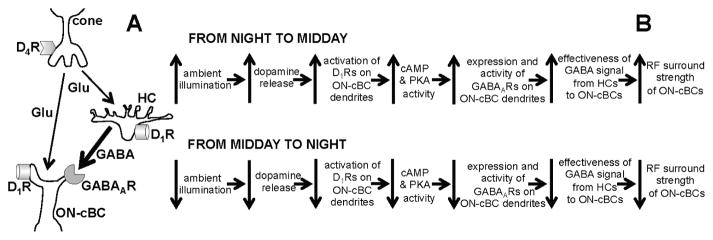Figure 1. Schematic diagram showing signaling between cone, cone bipolar cell and horizontal cell (A) and model of how light/dark regulation of the dopamine D1R/GABAAR pathway of ON-cone bipolar cell dendrites modulates surround light responses (B).
(A) Cones use glutamate (Glu) to signal cone bipolar cells (cBCs) and horizontal cells (HCs). The dendrites of cBCs and HCs have both dopamine D1Rs and GABAARs. Evidence also suggests that HCs provide a feedforward GABA signal to cBC dendrites (shown) and an inhibitory feedback signal to cones (not shown), but the roles of these pathways in producing cBC surrounds remain unclear. (B) Model that accounts for how both the effectiveness of the GABA feedforward signal to ON-cBC dendrites and the strength of ON-cBC surround responses are modulated by gradual changes in the ambient (background) light level. As ambient illumination slowly increases during the morning, reaching a peak at midday, D1R activation increases, which in turn augments intracellular PKA, so that the expression and activity of GABAARs on ON-cBC dendrites - including dendritic tips - are enhanced. As a result, the effectiveness of the GABAAR-mediated feedforward signal from HC dendrites to ON-cBC dendrites increases, enhancing the strength of surround antagonism and activation. Conversely, as background illumination slowly decreases during the afternoon and evening, reaching darkness at night, D1R activation is reduced. This in turn decreases intracellular PKA, substantially lowering GABAAR expression and activity so that ON-cBC surround strength is minimal. Experiments and findings in this study primarily address whether light/dark regulation of ON-cBC dendritic D1Rs and GABAARs modulates the strength of ON-cBC surround light responses.

